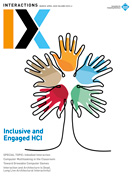Authors:
Mikael Wiberg, Alex Taylor, Daniela Rosner
We want to take this opportunity to introduce ourselves as the new editorial team for ACM Interactions magazine. Over the past couple of months, we—Mikael, Alex, and Daniela—have worked closely together to form a shared vision for how we want Interactions to evolve over the coming issues. The conversations have been tremendous fun, and our efforts have already resulted in some concrete outputs—not least, this, our first issue! Beyond these immediate duties, we have also set out a distinctive shape to the magazine, carefully and, we hope, sensitively building on its many past successes as we forge new paths.
Before saying more about our plans, we must first offer thanks to those who have given so much of their time and energy to the magazine up to this point. Here, a very special thank you to our predecessors, Gilbert Cockton and Simone Barbosa, and to the editors in chief who preceded them. Similar gratitude goes to unsung heroes such as the editorial team's outstanding assistant, Anne Spaa, and those who help behind the scenes at ACM, most notably John Stanik and Diane Crawford (although of course there are many more). Without question, all have demonstrated great commitment to the development of the magazine, and we are inspired at the prospect of expanding on their extraordinary achievements. Crucially, we must also thank you. All of you have made Interactions what it is today! It is through the contributions, the reading, and the conversations that surround the content that the magazine has flourished.
What has brought us together as an editorial team is a common interest in design and technology, and in particular the importance of keeping the floor open to new and alternative voices and ways of doing design. We are deeply sensitive to the people who aren't usually recognized in the annals of design and technology, and how versions of our work and the technologies we envision can inadvertently erase some pasts and presents, while amplifying and privileging others. These are the tensions and frictions that we will seek to make space for in the magazine, not foreclosing the debates but surfacing them to build the ground for new and different relationships with technology, that might just offer the conditions for more equitable and just futures.
Part of this work will involve attracting a diversity of contributors and, if possible, broadening the readership to promote rich and critical perspectives on technology and UX design. We also plan to develop and extend the format of the magazine. One of the biggest changes involves organizing content around particular debates or issues. Our hope is to put together a number of contributions (per issue) discussing a coherent theme, that engages readers, providing insight into the nuances that circulate technology and its design. To work toward a more inclusive and accessible format, we are setting our sights on multilingual translations, offering some content as open access (outside of the ACM Digital Library), and anchoring the magazine in values-based discussions. These ideas and others will take time to introduce. In the July-August issue, you'll see the first of our issues formed around a topic of debate, in this case the challenges of translating work for different audiences.
Coming back to the present, our current issue offers a number of exciting contributions from authors across the field! To set the stage, 2019 ACM SIGCHI Social Impact Award winner Gillian Hayes shares moving reflections on new forms of world building made possible through generous, open dialogue in her cover story, "Inclusive and Engaged HCI." Tracing these possibilities for engagement within and across bodies, m.c. schraefel curates a fascinating dialogue on the special topic of Inbodied Interaction, with contributions by Eric Hekler, Tom Gayler, Aaron Tabor, Elizabeth Murnane, Marion Lean, and Josh Andres in addition to schraefel. Our feature, forum, and Blog@IX articles add depth to discussions of HCI engagement, including work on multitasking in the classroom by Morten Hertzum and Lennart Björneborn, and automated driving by Christian P. Janssen and Andrew L. Kun. Meanwhile, Mariam Asad reminds us of the power of rereading with Audre Lorde—revealing matters of thought as habits of being.
Moving forward, we wish to continue and enlarge such engagements within Interactions. It is through all of you—through your individual and collective contributions, and through your discussions and debates that we hope to continue evolving the magazine. Our hope is to invite new voices in ways that expand its scope and focus its mission. Together we might build the conditions for alternative futures. Now, the floor is yours!
Mikael Wiberg, Alex Taylor, Daniela Rosner [email protected]
Copyright held by authors
The Digital Library is published by the Association for Computing Machinery. Copyright © 2020 ACM, Inc.








Post Comment
No Comments Found